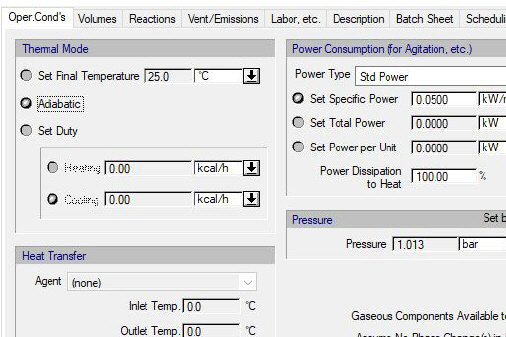

The following table shows a brief description of the variables appearing in this tab. The table also displays their default values and their generally acceptable range:
|
Variable |
Default Value |
Range |
|
|
||
|
◙ Final Temperature (oC) |
25.0 |
Positive |
|
◙ Heating Duty (kcal/h) |
0.0 |
Positive |
|
◙ Cooling Duty (kcal/h) |
0.0 |
Positive |
|
○ Heat Transfer Agent Name |
<Chilled Water> |
Any Heat Transfer Agent |
|
● Inlet Temp. (oC) |
5.0 |
Positive |
|
● Outlet Temp. (oC) |
10.0 |
Positive |
|
● Rate (kg/h) |
0.0 |
Positive |
|
○ Power Type |
<Std Power> |
Any Power Type |
|
◙ Specific Power (Per Volume) (kW/m3) |
0.1 |
Positive |
|
◙ Total Power (kW) |
0.0 |
Positive |
|
◙ Power Per Unit (kW) |
0.0 |
Positive |
|
○ Power Dissipation to Heat (%) |
100.0 |
[0,100] |
|
○ Pressure Set by User |
No |
Yes/No |
|
◙ Pressure (atm) |
1.0 |
Positive |
|
○ Allow for a Split After Reaction |
No |
Yes/No |
|
○ Gaseous Components Available to React |
Yes |
Yes/No |
Symbol Key: ○ User-specified value (always input); ● Calculated value (always output); ◙ Sometimes input, sometimes output
The following list describes the available specification choices in this tab; for more details on how these are implemented, see Stoichiometric Reaction Operations: Modeling Calculations.
•Pressure...
The pressure of the system, if not specified by the user, is set equal to the pressure of the previous operation.
•Gaseous Components Available to React...
If you don’t check the ‘Gaseous Components Available to React’ option, then only the liquid components will be considered for the reaction.
•Allow split after reaction...
If you check the option ‘Simulate Split After the Reaction’, then the Split Tab becomes available. This tab allows you to specify either total flow or specific component splits to the various streams exiting the vessel.